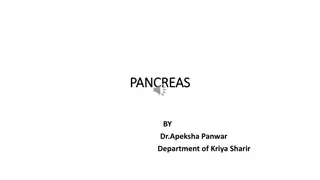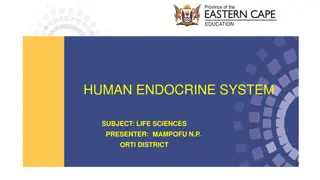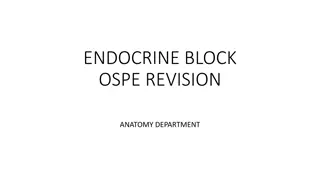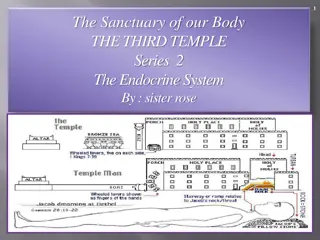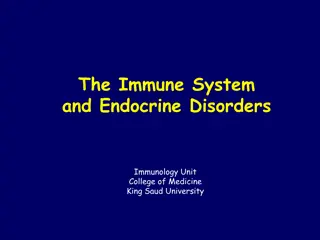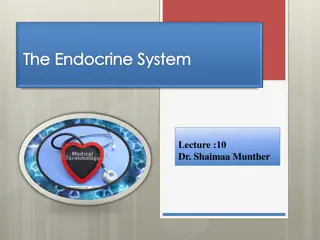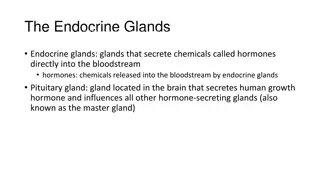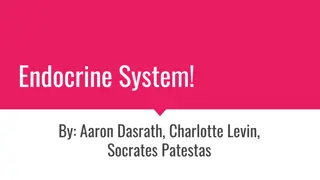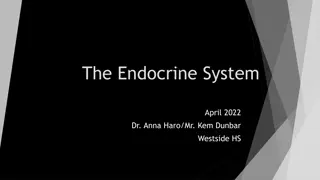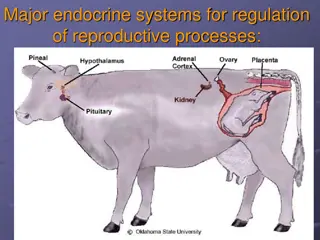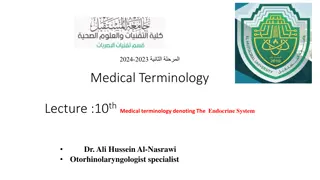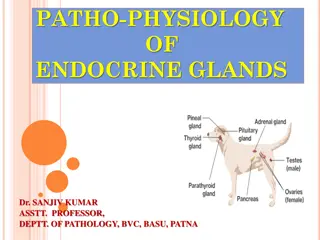The Endocrine System
The endocrine system consists of glands that secrete hormones into the bloodstream, affecting various bodily functions. Exocrine glands release secretions into ducts, while endocrine glands release hormones directly into the blood. Hormones target specific tissues to regulate activities. Explore the pituitary gland and its functions in hormone secretion and body regulation.
Download Presentation

Please find below an Image/Link to download the presentation.
The content on the website is provided AS IS for your information and personal use only. It may not be sold, licensed, or shared on other websites without obtaining consent from the author.If you encounter any issues during the download, it is possible that the publisher has removed the file from their server.
You are allowed to download the files provided on this website for personal or commercial use, subject to the condition that they are used lawfully. All files are the property of their respective owners.
The content on the website is provided AS IS for your information and personal use only. It may not be sold, licensed, or shared on other websites without obtaining consent from the author.
E N D
Presentation Transcript
HUMAN PHYSIOLOGY S.kavitha, Asst.professor(fsn) STC college
Endocrine System The endocrine system includes the endocrine glands and their hormones The function of the endocrine system is to secrete hormones into the bloodstream. Hormone: A Chemical messenger which targets a specific group of cells, in order to cause that group of cells do some activity or stop doing an activity.
Endocrine System Exocrine glands release their secretions into ducts, or tubes Liver Bile released into the gallbladder, then through a duct into the small intestine Pancreas releases pancreatic juice into the small intestine via a duct Endocrine Glands are called ductless glands Release hormones directly into the bloodstream Blood transports hormones throughout the body Each hormone acts on only a certain kind of tissue called its target tissue
Endocrine System Each hormone acts on a certain kind of tissue called its target tissue
Human Endocrine Glands Pituitary Thyroid Parathyroid Adrenal Pancreas (Islets of Langerhans) Testes and Ovaries
Pituitary Pituitary gland is a round organ about the size of a pea (~1 cm in diameter), located behind the bridge of the nose at the base of the brain Secretes 9 different hormones, which affect many different areas of the body, including: Growth Blood pressure Regulation of Pregnancy Breast milk production Sex organ functions in both men and women Thyroid gland function Metabolism Water regulation in the body (kidneys) Temperature regulation
A Few Pituitary Hormones Hormone Function Growth Hormone (GH) To increase body size during childhood and adolescence; to maintain body size during adulthood To stimulate the thyroid to produce thyroxin Thyroid Stimulating Hormone (TSH) Follicle Stimulating Hormone (FSH) Regulate puberty, development, and reproductive processes Stimulates the production of estrogen and testosterone Luteinizing Hormone (LH)
Growth Hormone Oversecretion of growth hormone: Giantism in childhood and acromegaly in adults (bones of face, hands and feet enlarge) Undersecretion of growth hormone: Dwarfism in childhood
Thyroid Located in the neck Releases hormone thyroxin Function is to regulate rates of metabolism in the body Essential for normal physical and mental development Oversecretion of thyroxin: Results in nervousness and weight loss Undersecretion of thyroxin: Results in cretinism (mental retardation, small size) in children
Thyroid Iodine deficiency in your diet results in goiter (enlargement of thyroid gland)
Parathyroid Function is to control metabolism of calcium Necessary for normal nerve and muscle function, blood clotting, healthy bones and teeth Located in back of thyroid gland (in neck) Hormone released is parathormone Undersecretion of parathormone results in nerve disorders, brittle bones and clotting problems
Adrenal Glands (Kidney Hats) Located at the top of each kidney Hormones released are cortisone and adrenaline Function of cortisone is to regulate carbohydrate, protein and fat metabolism promotes conversion of fats and proteins to glucose Function of adrenaline is to raise blood sugar levels and increases heartbeat and breathing rates
Adrenal Undersecretion of adrenaline results in the inability to deal with stress
Islet of Langerhans 13990 Located on the pancreas Hormones secreted are insulin and glucagon Insulin stimulates glucose uptake by cells Glucagon promotes conversion of glycogen (animal-based carbohydrate) to glucose
Blood Sugar Regulation Oversecretion of insulin results in low blood sugar Undersecretion of insulin results in high blood sugar This can lead to a condition known as diabetes
Diabetes-Type 1 Type 1- Usually found in children and young adults; the body doesn t make enough insulin Symptoms: Frequent urination Unusual thirst Extreme hunger Unusual weight loss Extreme fatigue and Irritability
Diabetes- Type 2 Type 2-Either the body doesn t produce enough insulin, or the cells ignore it. If you consume too much sugar over a long period of time, your body has to release large amounts of insulin. This can result in your cells building up a tolerance for insulin, which means they won t be affected by it. Symptoms: Any of the type 1 symptoms Frequent infections Blurred vision Cuts/bruises that are slow to heal Tingling/numbness in the hands/feet Recurring skin, gum, or bladder infections
Endocrine System Control Regulated by feedback mechanisms 2 types of feedback mechanisms 1. positive feedback 2. negative feedback
Feedback Mechanisms Negative Feedback mechanisms: Act like a thermostat in a home As the temperature cools, the thermostat detects the change and triggers the furnace to turn on and warm the house Once the temperature reaches its thermostat setting, the furnace turns off Example: Body sugar increases after a meal, so the pancreas secretes insulin, which tells the body s cells to take in glucose. Once blood sugar levels reach normal, the pancreas stops making insulin. Often used to maintain homeostasis
Negative Feedback Homeostasis is often maintained by two hormones who have antagonistic effects Each hormone does the opposite of the other. For example, if the blood pressure drops too low, the pituitary releases ADH, which causes the kidneys to reabsorb more water. If it the blood pressure increases too much, then the heart will release ANH, which will cause the kidneys to reabsorb less water.
Positive Feedback Mechanisms Positive Feedback mechanisms control events that can be out of control and do not require continuous adjustment Rarely used to maintain homeostasis Example of positive feedback found in childbirth Oxytocin stimulates and enhances labor contractions As labor continues, more oxytocin is produced Intensifies contractions until the baby is outside birth canal Oxytocin production stops and labor contractions stop


